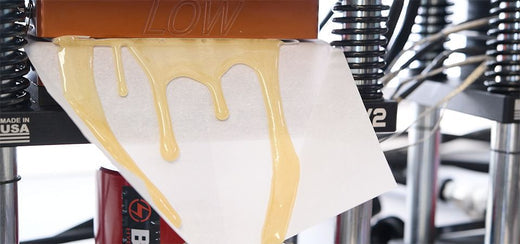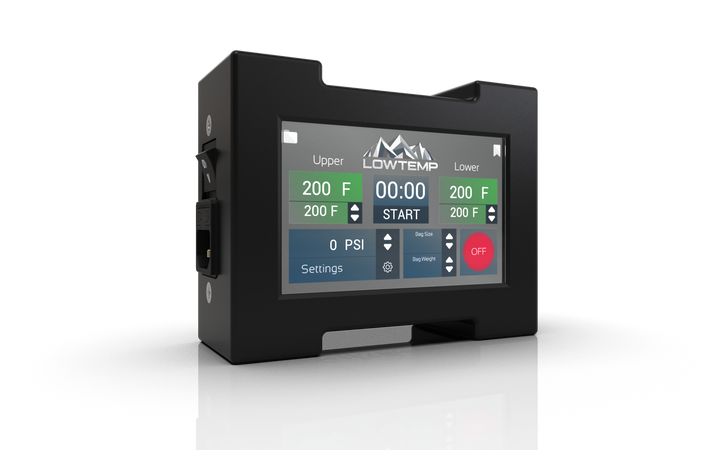How to Use a Rosin Press for Top-Quality Results

A rosin press allows you to make dabbable solventless extracts in as little as a few minutes when you have the right materials and tools. The beauty of today's professional-grade presses is that you can control the plate temperature and pressure with a high degree of precision for optimal results.
To begin, you'll need high-quality bubble hash, dry sift, kief, or dry cannabis flowers, a rosin press, micron-rated rosin bags, and food-grade parchment paper. Once you learn the steps and begin to experiment, you will soon discover which strains and pressing parameters produce the best results.
Choosing a Rosin Press
Rosin presses are H-shaped machines with two heated plates or platens—usually made from aluminum—that can be pressed together to mechanically extract the resin from bubble hash, dry sift, kief, and flower. The heat is generated by heating elements contained within each plate. The pressure comes from a pump, which can be manual, hydraulic, pneumatic, or hybrid.

For high-quality rosin, look for a rosin press that:
- Heats the plates evenly
- Gives you full control over the temperature and pressure
- Can handle your desired throughput
- Tracks and logs data for each press (the LT3 Heat and Pressure Controller gives you this ability)
- Is built to last (our American-made rosin presses, for example, come with a lifetime warranty)
20 tons of pressure is plenty for rosin extraction and you'll find that most rosin presses come with that capacity. Some high-end models come with computerized controls (or can be used with controller devices like the LT3) for greater precision, data tracking, and endpoint detection software.
Choosing Your Starting Material
You'll only produce fire from fire—the best quality rosin will come from premium starting materials. Besides a higher quality of rosin, starting with premium extracts or buds allows you to press at lower temperatures. This helps to preserve the terpenes and results in lighter-colored rosin, which has the greatest shelf appeal in dispensaries.
If you're pressing rosin from bubble hash or dry sift, you'll get the best results if your extract is fresh, clean, and has been stored at low temperatures to prevent oxidation.

If you're pressing flower rosin, start with flower that's:
-
Trichome-heavy
- Terpene-heavy (highly fragrant)
- Dried to 55-62% relative humidity
- Fresh (flower rosin pressed from buds that are less than two weeks post-harvest will generally be of higher quality)

You can measure the relative humidity of your buds by placing them in a mason jar with an analog or digital hygrometer (digital hygrometers are more accurate). During storage, a Boveda or Integra pack can keep your buds at the ideal humidity level until you're ready to press.
How to Press Rosin
The basic rosin extraction process is the same no matter which starting material you use. You simply apply heat and pressure and the trichome head cuticles will melt, causing the liquid resin to flow out.
To help you achieve great results from the get-go, we'll cover the rosin extraction process for flower, kief, and bubble hash separately with our recommended temperature and pressure guidelines for each.
How to Press Flower Rosin
Flower rosin is often the starting point for home extractors because it's accessible and quick. All you need are dried flowers, a rosin press, rosin bags (AKA rosin filter bags), and food-grade parchment paper and you can have a dabbable extract within minutes.

Extraction professionals generally focus on hash rosin (rather than pressing flower) because the resulting extract is lighter in color and has a cleaner flavor. However, for beginners, flower rosin is a great place to start.
To press flower rosin, you will need:
- A rosin press
- A 160μg rosin filter bag
- Food-grade parchment paper, pre-folded
- Dried cannabis flowers
- A pre-press mold (optional)
Steps:
- Remove the main stems from the buds and break them into popcorn-size chunks. It's not necessary to grind them.
- For easier pressing, use a pre-press mold to press the flowers into a compact brick. You can either line the pre-press mold with parchment paper and press the flowers before bagging or press the flowers after packing them tightly into a rosin bag.
- Pack the flowers into the bag (if you didn't do this before), compress it a little bit, and make sure you push the flower into the sides and corners of the bag so that rosin doesn't pool up in the spaces rather than flow out.
- Fold over the top of the bag. You'll want at least an inch of bag folded over.
- Place the folded bag into your pre-folded parchment paper. See our video on Parchment Tech for three of our favorite ways to fold. When folding your parchment paper, make sure that the silicone-coated side is facing in toward the rosin bag.
- Set the press to 190-220 °F. Higher rosin press temperatures are necessary when pressing flower rosin but you won't typically go as high when pressing hash, dry sift, or kief.
- Start to apply pressure using the pump. The technique will be slightly different depending on whether you're using a manual, pneumatic, or hydraulic rosin press pump. For flower, we typically apply up to 4,000 PSI of pressure on the gauge.
- Press until the flow of rosin slows and ultimately stops. In our experience, this generally takes 15-60 seconds for flower, depending on how much flower you're pressing.
See it done: We demonstrate a flower squish on the Lowtemp V2 Rosin Press in the video Part 1: How to Press Rosin for Beginners (Flower).
How to Press Kief Rosin
You can make kief rosin using the kief that's collected at the bottom of your cannabis or coffee grinder. Kief rosin often contains some plant matter but it's still smokable. We’d only recommend it for personal use though as it’s not of a high enough grade to sell. For this press, you'll need a stainless-steel funnel and a smaller-micron rosin bag and will apply less pressure than you would for whole cannabis flowers.
Materials:
- Rosin press
- Stainless-steel funnel
- One or two 25μg rosin bags
- Food-grade parchment paper, pre-folded
- Kief
Method:
- Tip the kief through the stainless steel funnel into the 25μg bag.
- Trim off any excess bag length (leaving 1 inch) and fold the top over.
- If pressing high-quality kief, place the folded-over bag inside a second bag ("double bagging") and fold over the top of the second bag. This helps to prevent blowouts.
- Place the bag(s) inside the pre-folded parchment paper and place this “pod” between the plates of the rosin press.
- Set the press to 190 °F (180-200 °F is our preferred range for pressing kief).
- Apply pressure. For kief, we generally apply 300-900 Platen PSI. "Platen PSI" is the pressure "at the plate"—the pressure that's being applied to the rosin bag—rather than the reading on the pressure gauge. See our video Part 2: How to Press Rosin for Beginners (Kief) to learn how to calculate platen PSI.
- Press for 20-60 seconds, until the rosin stops flowing out.
How to Press Hash Rosin
Hash rosin is the preferred extract among professionals because it's the cleanest tasting and lightest colored of all rosin types. Because bubble hash is already very pure, labs generally use cold pressing temperatures (160-180 °F) for the maximum preservation of terpenes and the lightest rosin color.
Materials:
- Bubble hash (dried)
- The same tools that you would use for pressing kief. In our video Part 3: How to Press Rosin for Beginners (Bubble Hash), we explain that the stainless steel funnel should preferably be pre-chilled.
Method:
- Steps 1-4: Follow the same method as for kief, then put the bag-and-paper pod between the plates on the rosin press. For bubble hash, we would always recommend double-bagging.
- 5. Set the press to 160 °F.
- 6. Start to apply pressure slowly. For hash, we generally apply 300-900 Platen PSI.
- 7. Press for 20-60 seconds, until the rosin stops flowing out.
Post-Pressing Techniques
Rosin is ready to dab right off the press but should be jarred and preferably cured if you're producing extracts for sale to consumers.
- Use a dabbing tool to separate the rosin from the parchment paper. If the rosin is sticking to the paper, it may help to refrigerate the rosin and parchment paper first or to put the parchment paper on something cold like a frozen plate or an ice pack.
- Stretch the rosin (Taffy Tech), knead it, and roll it into a ball before jarring or put it in a glass jar and whip it with a dabbing or collection tool.
- After placing the rosin in the jar, seal the jar and cure the rosin using a cold curing or warm curing process with Jar Tech to create a wide range of textures and products. Products that can be made from rosin include badder and budder, rosin jam, sauce and diamonds, rosin carts, rosin edibles, and more.
Rosin Pressing Tips
There are several tricks to make the rosin pressing process easier and prevent the most common problems. The following are just a few of the things we've learned over the years.
Preheat Bubble Hash and Dry Sift Before You Press
Bubble hash and dry sift are more delicate than flower and it can help to allow for a brief preheating period.
- Place the rosin-bag-parchment-paper pod between the plates when they're warm to the touch.
- Bring the plates close enough together that they're just touching the top and bottom of the rosin bag.
- Wait for 10-30 seconds or until the hash starts to bubble at the front of the bag. Then slowly start to apply pressure.
While some people preheat flower before pressing, we have personally found that flower is much more forgiving and it isn't usually necessary to wait.
Use Structural Support for Hash
Hash rosin is the "bees' knees" when it comes to solventless extracts and you don't want to lose yield or quality to a blowout. Our Bulletproof Stitchless Rosin Pouches are around 95-98% effective in preventing blowouts when used over the 25μg pouch for hash squishes.
Experiment with Folding Techniques
There are several ways to fold parchment paper for encouraging directional flow when pressing rosin. Experiment with each method to see what works best for you:
- Boat Tech allows for single-directional flow. This is advantageous if you want the rosin to flow directly into a jar or collect on the folded-up "tail" of the parchment paper for collection.
- Burrito Tech allows for dual-directional flow, i.e. rosin can flow out of both sides of the press. This minimizes the distance the rosin needs to travel.
- Waterfall Tech is used when you intend to press a series of "pods" onto a larger piece of parchment paper such as our Die Cut Waterfall Collection Parchment for large-quantity processing. We created a video to show what Waterfall Parchment Rosin Pressing looks like in action (take a moment to watch it, it's beautiful).
Lab-Test Your Rosin for THC and THCA
This is one for the pros, especially those that want to create award-winning rosin. Rosin samples entered in High Times Cannabis Cups over the years preceding 2016 had significantly higher percentages of decarboxylated THC than BHO and non-solvent hash entries. It was found, however, that this percentage improved as people got better at making rosin. Lab testing will help you measure the cannabinoid profile of your extracts so you can see how you’re tracking and how different parameters and techniques affect your results.
Record Everything
Once you discover a winning formula, you want to make sure you can produce the same results again. Write down everything—starting material, micron size, temperature, pressure, and pressing time—for each batch. Better still, get our LT3 Heat and Pressure Controller to capture highly detailed data for each squish and store this data automatically in the desktop app.
Premium Rosin Is Within Your Reach
Quality and attention to detail are essential when it comes to pressing rosin professionally. You'll want to look for trichome-rich buds that aren't more than a week or two old, a professional-grade rosin press, quality parchment paper, and strong rosin bags that won't become damaged or break under pressure.
Once you have the right materials, you can play around with the parameters, parchment folding techniques, and post-processing techniques such as hot or cold curing to see what works best for you. As long as you document everything you do, you should be able to reproduce your best results time after time.
Products Mentioned in This Article

LT3 Rosin Press Heat and Pressure Controller
$549
Introducing the LT3 Rosin Press Heat Controller – the ultimate solution for precise temperature and pressure control for rosin extraction. Designed with the user in mind, the LT3 is the perfect tool for amateur and professional rosin enthusiasts. Proudly Made in the USA, this advanced heat controller boasts many innovative features that make it stand out in the market.



